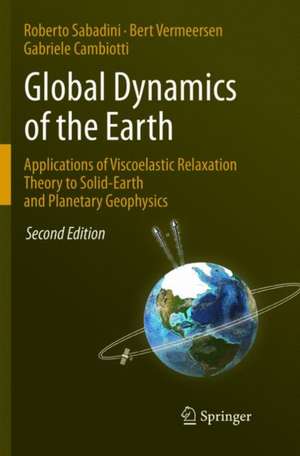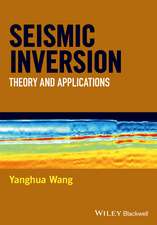Global Dynamics of the Earth: Applications of Viscoelastic Relaxation Theory to Solid-Earth and Planetary Geophysics
Autor Roberto Sabadini, Bert Vermeersen, Gabriele Cambiottien Limba Engleză Paperback – 31 mai 2018
| Toate formatele și edițiile | Preț | Express |
|---|---|---|
| Paperback (1) | 464.35 lei 38-44 zile | |
| SPRINGER NETHERLANDS – 31 mai 2018 | 464.35 lei 38-44 zile | |
| Hardback (1) | 897.29 lei 3-5 săpt. | |
| SPRINGER NETHERLANDS – 6 iun 2016 | 897.29 lei 3-5 săpt. |
Preț: 464.35 lei
Nou
Puncte Express: 697
Preț estimativ în valută:
88.85€ • 93.00$ • 73.95£
88.85€ • 93.00$ • 73.95£
Carte tipărită la comandă
Livrare economică 27 martie-02 aprilie
Preluare comenzi: 021 569.72.76
Specificații
ISBN-13: 9789402413786
ISBN-10: 9402413782
Pagini: 358
Ilustrații: XVI, 358 p. 117 illus., 23 illus. in color.
Dimensiuni: 155 x 235 mm
Ediția:Softcover reprint of the original 2nd ed. 2016
Editura: SPRINGER NETHERLANDS
Colecția Springer
Locul publicării:Dordrecht, Netherlands
ISBN-10: 9402413782
Pagini: 358
Ilustrații: XVI, 358 p. 117 illus., 23 illus. in color.
Dimensiuni: 155 x 235 mm
Ediția:Softcover reprint of the original 2nd ed. 2016
Editura: SPRINGER NETHERLANDS
Colecția Springer
Locul publicării:Dordrecht, Netherlands
Cuprins
1. Viscoelastic Relaxation Theory, Momentum and Poisson Equations.- 2. Incompressible and Compressible Analytical Viscoelastic Models.- 3. Rotational Dynamics of Viscoelastic Planets Linear Theory.- 4. TPW and J2 Induced by Ice-Sheet Loading.- 5. Detection of the Time-Dependent Gravity Field and Global Change.- 6. Sea-Level Changes.- 7. TPW driven by Subduction. Non-linear Rotation Theory.- 8. Post-seismic Deformation.- 9. Icy moons.- Appendices.- Index.
Notă biografică
Prof. Roberto Sabadini is Full Professor of Solid Earth Geophysics at the Department of Earth Sciences, University of Milano, Italy. His focus is on the role of Earth’s viscoelasticity, particularly within the frame of an analytical approach, applied to a variety of geophysical phenomena, from postglacial rebound to those related to mantle density anomalies, from secular polar motion to post-seismic deformation. This modelling looks at the Earth in an integrated fashion and links the physics of its interior with the newly acquired gravity and deformation data from space geodesy.
Prof. Dr. Bert Vermeersen is Full Professor of Planetary Exploration at the Faculty of Aerospace Engineering and at the Faculty of Civil Engineering and Geosciences of Delft University of Technology in The Netherlands. He is also a Senior Researcher on sea level change at the Royal Netherlands Institute for Sea Research NIOZ in The Netherlands. Prof. Vermeersen's focus of his planetary exploration research is on the moons of Jupiter and Saturn. At NIOZ his research concentrates on sea level change for both the present day and for geological periods.
Dr. Gabriele Cambiotti is Researcher at the Department of Earth Sciences at the University of Milano, Italy, where he teaches the courses of Seismology and Mathematical Methods for Geophysics. His research focuses on viscoelastodynamics and the modeling of glacial isostatic adjustment, mantle convection and seismic cycle. He studies basic physical and mathematical issues related to viscoelastic deformation. Long term Earth’s rotation and gravitational seismology are also keys in his research.
Textul de pe ultima copertă
This volume opens up new perspectives on the physics of the Earth’s interior and planetary bodies for graduate students and researchers working in the fields of geophysics, planetary sciences and geodesy. It looks at our planet in an integrated fashion, linking the physics of its interior to geophysical and geodetic techniques that record, over a broad spectrum of spatial wavelengths and time scales, the ongoing modifications in the shape and gravity field of the planet. Basic issues related to the rheological properties of the Earth and to its slow deformation are considered, in both mathematical and physical terms, within the framework of an analytical relaxation theory. Fundamentals of this theory are developed in the first two Chapters. Chapters 3-9 deal with a wide range of applications, ranging from changes in the Earth’s rotation to post-seismic deformation and from sea-level variations induced by post-glacial rebound to tidal deformation of icy moons of the Solar System. This Second Edition improves substantially our formalism implementing compressibility in viscoelastic relaxation. Chapter 5 now contains new developments in the physics of the gravitational effects of large earthquakes at subduction zones, made possible by new gravity data from space missions. The new Chapter 9 of this Second Edition on deformation and stresses of icy moons enlarges the applications of the book to Planetology, dealing with the additional complications in the theory of viscoelastic relaxation introduced by the shallow low-viscosity zones and inviscid water layers of the moons of Jupiter and Saturn.
Caracteristici
Self-contained textbook on how to model viscoelastic relaxation, within the frame of most advanced analytical approaches, aimed at acquiring a deep insight into the physics of the modelled geophysical phenomena Contains the widest spectrum of geophysical processes where viscoelastic relaxation plays a key role, from post-seismic deformation to geoid anomalies and polar displacements driven by density anomalies due to mantle convection, including post-glacial rebound and sea-level changes Accounts for the newest developments in Planetology, dealing with viscoelastic relaxation of ice moons of the Solar System squeezed by tidal forces, most interesting planetary bodies that might offer chances for natural habitat and even extraterrestrial life forms, thanks to possible liquid layers under their icy crust Includes newest developments on True Polar Wander driven by internal sources Contains the newest applications of gravity data from space gravity (GRACE) in post-glacial rebound studies, aimed at estimating the present-day mass imbalance in Greenland and Antarctica, as well as the retrieval of the Centroid Moment Tensor solution from huge thrust earthquakes at subduction zones Includes supplementary material: sn.pub/extras












